By Christopher Rollyson 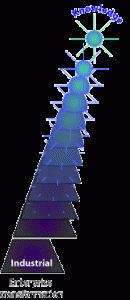 What does the Knowledge Economy Portend for the Industrial Economy organization? What does the Knowledge Economy Portend for the Industrial Economy organization?
Today, most of the world’s global commercial and governmental organizations increasingly find themselves confronted by the Knowledge Economy’s new success factors, which are often contrary to the Industrial Economy’s. Compounding the challenge, past competitors have had similar structures and limitations to incumbents’, which gave everyone more time to adapt to change; however, new Knowledge Economy competitors often do not have the same structures and limitations. Technology and globalization are changing the rules of engagement.
These developments leave industrial companies in an awkward situation. Now, they need to excel at collaborative innovation—historically a weak point—to capture and hold customers’ attention. In the Knowledge Economy, innovation will replace efficiency as the primary driver of value creation. Competitors that can engage rapidly shifting customer desires will dominate.
To succeed, incumbents must quickly become more adaptive and collaborative with external partners and customers. Moreover, they must transform themselves while they continue to operate at increasing levels of performance.
| Industrial Economy Success Factors |
Knowledge Economy Success Factors |
| Deliver vast quantity and low prices to relatively few broad demographics |
Deliver unprecedented choice to many narrow customer segments; low prices table stakes |
| Tightly integrated command/control organization |
Loosely coupled collaborative networked organization |
| Failed new offering launches are the rule because it’s a low velocity, internally-focused research/ produce/ sell process |
New offering launch processes are high velocity and feature customer input and collaboration with external specialists |
| Off-line consumers isolated and passive; buying decisions usually made using company-influenced information; consumers can’t easily find consumer-produced information |
On-line customers validate each other’s interests and influence purchases, creating micro-markets with unique demands; this will be the rule in emerging markets, where on-line is the default for new middle classes |
| Focus on product/service features |
Focus on customer experience |
New Structural Capability Enables New Level of Customer Focus
The increased practice of (out)sourcing is enabling the enterprise to evolve in order to meet the challenges of Knowledge Economy customers. (Out)sourcing failures and successes are educating enterprises and their providers about new IT-enabled options for executing (and redesigning) business processes. Forward-thinking executives are realizing that their options for business process execution and competency definition will continue to increase in step with their sophistication in sourcing.
In the Knowledge Economy, the enterprise’s networked structure enables it to put customer needs before the needs of the organization. Even today, most corporate “organizations” are defined by their positions within their enterprises’ organizational structures, and their actions are defined by their performance within the departmental context. Thanks to “reengineering” pioneers, executives began to appreciate the relevance of the business process orientation in the 1980s, but very few organizations have truly been transformed. The organization has been the required mechanism to deliver value to the customer, but it adds little value to the customer today (its services do).
What if the company could deliver the services without the organization?
The industrial organization is large, complex and expensive, and maintaining its optimal function too often requires the enterprise to focus on itself at the expense of the customer. If the company were to separate the organizational structure from the services it delivers, the company could transform how it delivers value to customers.
E-Business, the application of open standards-based Internet technologies and processes throughout enterprises of all sizes, has provided a capability to change all this. Because executives increasingly have granular, real-time information about business processes, they can change the model: in effect, the degree of information available renders the “organization” far less relevant today, and the stage is set to move the customer-serving business process in the forefront.
What does this mean? First, execute the process in the way that is most advantageous to the customer, based on the nature of the customer’s request and the enterprise’s ability to fulfill it at that moment in time. Real-time, granular information can begin to enable executives to understand that the context around requests (for products or services) and their fulfillment is in constant flux. Previously, executives did not have the information or visibility.
But “organizations,” which were required prior to the e-business era to manage inflexible actions that coordinated complex inputs to produce and deliver products/services, are no longer required.
Because each part of a business process increasingly can self-report its status, it can be reconfigured on the fly as needed. In other words, processes will increasingly self-organize.
Self-organization
Self-organization is a future state that already exists in pockets today, and it will be more true every month that passes. But executives have a serious legacy problem: organizations have provided the structure and coordination to marshall tremendous resources to produce vast amounts of product very efficiently. If they want to dismantle them in favor of the business process, how can this be accomplished? How does one change a tire while the car is still rolling? It is well established that organizations struggle with “adaptiveness.” Why? Their method of making order out of chaos has been scale and its inflexibility. They have “tightly coupled” (inflexible) processes, which were required due to the massive process dependencies within the enterprise.
The future state calls for enterprise organizational structures to devolve into “business components” that fulfill service requests from each other using standardized communications (business services). Such business components will organize themselves around service requests. Of course this idea is by no means new; however, I.T. maturation, business process digitization and the rapidly developing, robust outsourcing provider market make process-focused transformation actionable today. What is missing is an approach to deliver the vision incrementally yet decisively. Transourcing™ is that approach.
For a more detailed treatment of organizational transformation, see transourcing.com.
By Christopher Rollyson Media Reflects Power Shift away from Producers to Consumers—Glimpses of Consumer Empowerment
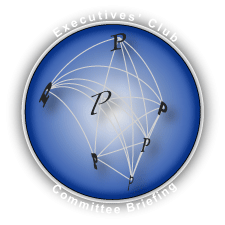 The Executives’ Club of Chicago assembled a visionary panel to give Midwest business leaders their advice for media communications in the (“new” ,^) digital age. Rishad Tobaccowala, CEO, Denuo Group and Chief Innovation Officer, Publicis; Dr. Jim Taylor, Vice Chairman, The Harrison Group and Emily L. Barr, President & General Manager, ABC 7 Chicago were panelists, and Susan D. Whiting, Chairman, Nielsen Media Research moderated the breakfast, which took place 30 January 2007 at Chicago’s Mid-America Club. The Executives’ Club of Chicago assembled a visionary panel to give Midwest business leaders their advice for media communications in the (“new” ,^) digital age. Rishad Tobaccowala, CEO, Denuo Group and Chief Innovation Officer, Publicis; Dr. Jim Taylor, Vice Chairman, The Harrison Group and Emily L. Barr, President & General Manager, ABC 7 Chicago were panelists, and Susan D. Whiting, Chairman, Nielsen Media Research moderated the breakfast, which took place 30 January 2007 at Chicago’s Mid-America Club.
Ours is rapidly becoming a P2P world in which individuals communicate with individuals digitally, and this represents a profound shift for media companies, their clients and everyone’s customers. The focus of the morning discussion was “media”—television, print, radio—which are still largely organized to deliver one message to an audience of many. Of course, the “mass” has always been comprised of individuals, but their alternatives to mass media have been few until fairly recently. Now they are tuning out mass messaging in favor of more relevant communications, which increasingly come from—other individuals. Meantime, people are increasingly connected via the Internet (whether through mobile phones, computers, cable, VoIP), and the scale of consumer communications is beginning to approach that of the mass media.
What global enterprises and their media advisors want to know is, “How do we evolve and ensure that we remain relevant in light of this emerging consumer empowerment?”
By Christopher Rollyson An Excellent Primer for the Core Competency of the 21st Century
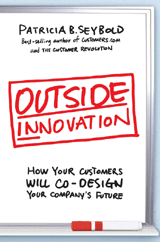 To thrive in the Knowledge Economy, companies will have to learn how to innovate at warp speed, or they will simply slip beneath the surface of the water like stricken liners. Ultra low costs and exceptional quality feature sets are merely expected, and they no longer differentiate. To thrive in the Knowledge Economy, companies will have to learn how to innovate at warp speed, or they will simply slip beneath the surface of the water like stricken liners. Ultra low costs and exceptional quality feature sets are merely expected, and they no longer differentiate.
Conventional wisdom holds that “innovation” cycles reappear every five years, when companies have exhausted the then-current cost-cutting approaches and need to focus on driving the top line.
However, the Knowledge Economy doesn’t call for your father’s innovation. The 21st century kind will require that companies turn themselves inside-out. Winners will learn to engage and catalyze their customers’ creativity. As author Patty Seybold aptly puts it, “Companies with the smartest customers win.” Outside Innovation is an in-the-trenches manual for evolving your company to embrace the innovation imperative.
By Christopher Rollyson We Must Rethink Learning in the Knowledge Economy
 Academicians everywhere are struggling to improve their students’ competitive standings in the global Knowledge Economy, which levels the playing field in many respects. It is far easier to build a world-class competitor in the Knowledge Economy than it was in the Industrial Economy. A strong educational system is a must, along with a highly motivated population, decent infrastructure and incentives for foreign investment. In former times, being a world competitor necessitated gaining control of vast natural resources to produce a strong industrial base from which world-class armies and navies would be built. India currently exemplifies the Knowledge Economy model very well*, and countries worldwide have taken note. Academicians everywhere are struggling to improve their students’ competitive standings in the global Knowledge Economy, which levels the playing field in many respects. It is far easier to build a world-class competitor in the Knowledge Economy than it was in the Industrial Economy. A strong educational system is a must, along with a highly motivated population, decent infrastructure and incentives for foreign investment. In former times, being a world competitor necessitated gaining control of vast natural resources to produce a strong industrial base from which world-class armies and navies would be built. India currently exemplifies the Knowledge Economy model very well*, and countries worldwide have taken note.
However, the Knowledge Economy is drastically changing what people need to learn to succeed, and educators haven’t caught up yet. They are teaching according to Industrial Economy rules, which compromises the performance of their students.
Educators have a special opportunity to create competitive advantage by realizing that the learning proposition is far different today—due to the Knowledge Economy and the role of information in adding value. The speed of change in all parts of the world is far greater today than at any previous time, and this is largely due to increased communication—information flow among people. More information exchange leads to greater dynamism and iterations (changes and adjustments based on communication). This has a huge impact on education: for most of humankind’s existence, the young would “learn” a trade or profession, enter the trade and learn refinements on the job. Hence schooling. Today, however, the knowledge base of all trades and professions changes so quickly that the shift is to continuous learning. This is fairly well recognized.
Less obvious and even more important is the necessity of rebalancing what we learn. Since our origin as a species, information has been rare, so a large part of learning has been acquiring information and committing it to memory. Having information in memory was important because information-retaining devices were few. Prior to the printing press, information was passed from one generation to the next orally, through poems and stories. Today, information on demand can increasingly be assumed, and people add the most value by learning how to select, assimilate, analyze and apply information. Therefore, the emphasis must be on analytical skills and empathy for customers, who form the “application context” of much of the Knowledge Economy.
However, many educators are still encumbered by the assumption that “more is better” will produce stronger performance. The degree of information, and even knowledge, that is available will only increase exponentially. Whether students, artists or business executives, people will add the most value by creating and applying knowledge to obtain a differentiating result. In other words, they will live in an abstracted world in which they are aware of what information means, how it resonates or creates dissidence with other information and how to apply it to please a customer. This requires the ability to think, reflect and collaborate.
A recent article, Schools Turn Down Heat on Homework, (The Wall Street Journal, 19 January 2007; also see Stanford reprint), discusses how several elite schools in the U.S. are curtailing the amount of homework their teachers assign due to several recent studies that question the effectiveness of homework. Research cited shows that homework above a certain level actually is counterproductive to math and science scores. One of the highest scoring nations, Japan, actually has little homework; in fact, many of Japan’s elite schools banned homework in the 1990s.
As I’ve written extensively, innovation will be the engine of value creation in the Knowledge Economy, and innovation requires jumps in thinking, collaboration and creativity. Wrote thinking is counterproductive because people get stuck. Less homework will not help many students unless it is accompanied by more analysis and reflection, unless it guides students in being aware of what they are learning. This will prove to be extremely challenging because reflection requires attention, which is very scarce and getting more so. Many students are also short-changing themselves by focusing on an immediate result (passing O-levels, exams) and not pausing to think.
In this, humankind is its own worst enemy. Reflection and attention can be thought of as focus. With so much information and knowledge available, how to focus? The current generations are under enormous stress because they/we haven’t yet learned how to deal with the amount of information that it increasingly available. Our brains, attitudes and habits are still wired with the “information is scarce” assumption, so we are overloaded, and our attention suffers. It will take some time to rewire our brains and habits.
Analysis and Conclusions
- It is difficult to appreciate the profound impact of information on demand and how it changes how we must learn. Abstract thinkers will excel the most, all else equal, because they have several levels of awareness of the subject under consideration. In the U.S., education is seriously compromised by the lack of emphasis on abstract thinking and philosophy.
- Abstract thought is critical in several ways:
- It aids in the connection with unfamiliar patterns of thought and can therefore help to discover opportunity and drive innovation
- It is quintessential to meta-knowledge, to “knowing what we know”
- It helps to “mash up” people or things that haven’t been combined before
- It aids the imagination in a structured way to develop awareness of what factors are in a set and how a changed context might alter the effectiveness of one or more of the factors
- In business and government, leaders create differentiated value. “Differentiated” refers to thinking, acting and producing distinctly from how others have done before.
- Increasingly, we live in a networked world, and a safe assumption is that collaboration with people with different “knowledge bases” will drive the ability to innovate. Therefore, having collaborative learning environments will be a critical success factor.
- Sensitivity and empathy for other people and ideas are also critical, and all cultures could improve in this area.
- *China’s success as an economy eclipses India’s in many respects, but India currently reflects the purely knowledge-driven economic model best. China is developing a strong industrial economy first, which will become more knowledge-oriented over time.
By Christopher Rollyson 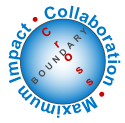 Two recent articles show that even the most intractable problems can be overcome when organizations find ways to align their goals. Sometimes collaboration makes for strange bedfellows—like the military and environmentalists—but opportunity is often highest when when “mashing up” groups that are not used to working together. Innovation can produce surprising value when leaders open their minds, challenge conventional wisdom and make unthinkable changes—like paying a hospital more for treating patients less. Two recent articles show that even the most intractable problems can be overcome when organizations find ways to align their goals. Sometimes collaboration makes for strange bedfellows—like the military and environmentalists—but opportunity is often highest when when “mashing up” groups that are not used to working together. Innovation can produce surprising value when leaders open their minds, challenge conventional wisdom and make unthinkable changes—like paying a hospital more for treating patients less.
These stories are as inspiring as they are instructive because the people involved questioned assumptions, and I hope you enjoy them.
Healthcare Costs Hit in Solar Plexus
Virginia Mason Medical Center is Seattle’s third largest health care provider, and it began innovating in several areas after receiving a wake-up call from Aetna, one of the area’s largest insurers. In 2004, Aetna shared the results of a study that compared treatment costs of Seattle area hospitals. Several of Virginia Mason’s specialty practices were significantly more costly than alternatives, and Aetna was considering excluding those areas from coverage. In the ensuing two years, Virginia Mason innovated by using new workflow strategies in targeted treatment areas. For example:
- In the spine clinic, they reversed the position of physical therapy from a relative afterthought to the front of the treatment process for back pain, which reduced the percentage of patients receiving MRI tests by one third, while significantly reducing patient waiting times. This was a hot button for Starbucks .
- For migraine headache treatment, the hospital offered special training on when to offer MRIs, which reduced MRIs from 50% to 5% of migraine cases.
However beneficial these changes were, they wreaked havoc in the hospital’s economics because MRIs are very profitable (a $850 cost that produced $450 in profit). Even though treatment processes were more streamlined and area employers like Costco, Starbucks and Nordstrom saved six figures the first year, the hospital began losing money because insurers pay generously for high-tech treatments, and physicians, trained not to consider cost, order the tests as a matter of habit:
“The payment system is so toxic,” says Francois de Brantes, a former health-care program director at General Electric Co. “Unless you tackle it, any health-care reform doesn’t have much chance.”
Here’s where the employers went to bat for Virginia Mason. As Aetna’s customers, they encouraged the insurer to increase its payments to the hospital for the lower tech treatments, which Aetna is doing. Notably, the area’s other two large insurers, Regence Blue Shield and Premera Blue Cross, have not made adjustments to reward the efficiencies.
For more, please read “A Novel Plan Helps Hospital Wean Itself Off Pricey Tests,” The Wall Street Journal, 12 January 2007 (subscription or access to Proquest required).
Unusual Duo Expands Nature Habitats across U.S.
The U.S. military currently has about 30 million acres of training bases across the country, and they increasingly come into conflict with urban sprawl. Of course, most bases were very remote when they were built, but the bases’ new neighbors don’t appreciate the sounds of military training. Enter the Readiness and Environmental Protection Initiative,” which enables the military to work with environmental groups to buy land around the bases for conservation purposes. The land serves as a buffer zone between the military and urban development, which displaces animals.
It is a rather unorthodox arrangement, but it benefits both parties, at the bases reduce contact with homeowners, and environmentalists can help more animals and plants:
“The last people I ever thought I’d be working with were guys in black berets and camouflage uniforms,” says Joshua Stanbro, a manager of the Trust for Public Land, of San Francisco, who worked on the Hawaii project. “Now, I count them as friends.”
Others are not so sanguine, pointing to toxic residues and ammunition dropped in forests. However, the military is becoming more responsive to environmental concerns, and environmentalists have been able to create thousands of acres of habitats for endangered species. To overcome environmentalists’ reticence, the Pentagon began exhibiting at environmental trade shows, which raised eyebrows at first.
For more, read “Another Shade of Green: Military Aids Nature Lovers” (subscription or access to Proquest required).
Analysis and Conclusions
If we define innovation as discontinuous change that is brought to market, it makes sense that unusual partnerships have great potential to collaborate and innovation. The main barrier is “us and them” thinking.
By Christopher Rollyson Economic Outlook for 2007 Reveals Pockets of Opportunity + Political Handicapping
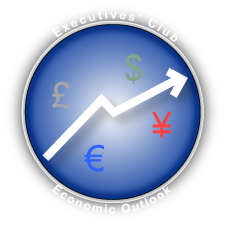 The Executives’ Club of Chicago assembled an all-star panel to give Midwest business leaders their guidance for various aspects of the U.S. economy in 2007. Diane Swonk, Chief Economist of Mesirow Financial, Alan Murray, Assistant Managing Editor of The Wall Street Journal and Robert “Bob” Froehlich, Chairman of the Investment Strategy Committee, Deutsche Asset Management broke out their respective crystal balls for 2007, and the audience was not disappointed for lack of insight or wit. The session was scintillatingly moderated by Terry Savage, Financial Columnist of the Chicago Sun-Times. The Executives’ Club of Chicago assembled an all-star panel to give Midwest business leaders their guidance for various aspects of the U.S. economy in 2007. Diane Swonk, Chief Economist of Mesirow Financial, Alan Murray, Assistant Managing Editor of The Wall Street Journal and Robert “Bob” Froehlich, Chairman of the Investment Strategy Committee, Deutsche Asset Management broke out their respective crystal balls for 2007, and the audience was not disappointed for lack of insight or wit. The session was scintillatingly moderated by Terry Savage, Financial Columnist of the Chicago Sun-Times.
The consensus was that the U.S. economy would have a relatively benign year in 2007. All panelists predicted a higher Dow, and their predictions concurred with Wall Street’s most accurate ,^) indicator, the Super Bowl Predictor. Little of import will happen on the political front, the U.S. economy will grow at a slower pace, and investment returns will be generally highest outside the U.S. Elsewhere, consumer empowerment reared its head in the executive pay issue, Apple will remain an enigma for investors who don’t understand customer experience, and the U.S. will have to get over itself in order to realize its potential in the Knowledge Economy.
By Christopher Rollyson China Analysis and Outlook 2007 offers political insight into the global knowledge market.
 The Strategic Management Association, the Harvard Business School and the CDMA sponsored the 2007 China Outlook, which was given by Lyric Hughes-Hale, Founder China Online in Chicago 9 January 2007. Her presentation was preceded by David Hale’s 2007 Economic Forecast. The Strategic Management Association, the Harvard Business School and the CDMA sponsored the 2007 China Outlook, which was given by Lyric Hughes-Hale, Founder China Online in Chicago 9 January 2007. Her presentation was preceded by David Hale’s 2007 Economic Forecast.
As a long-time China watcher and analyst, Lyric has rare and unusual insights to which I’ll try to do justice before giving my observations. The Global Human Capital Journal also covered the 2006 China Outlook.
Continue reading China Analysis and Outlook 2007
By Christopher Rollyson Economic Insight Behind the Global Knowledge Market
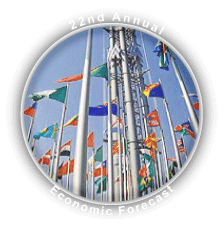 The Strategic Management Association, the Harvard Business School and the CDMA sponsored the 2007 Economic Forecast featuring David Hale, Chairman of Prince Street Capital Management and Lyric Hughes-Hale, Founder China Online. David has international renown as an international economist, and he presented his encyclopedic knowledge and perspective on global economic trends in Chicago on 9 January 2007. Afterward, Lyric shared her insights on China in Part II of the evening. The Global Human Capital Journal also covered the 2006 Economic Forecast. The Strategic Management Association, the Harvard Business School and the CDMA sponsored the 2007 Economic Forecast featuring David Hale, Chairman of Prince Street Capital Management and Lyric Hughes-Hale, Founder China Online. David has international renown as an international economist, and he presented his encyclopedic knowledge and perspective on global economic trends in Chicago on 9 January 2007. Afterward, Lyric shared her insights on China in Part II of the evening. The Global Human Capital Journal also covered the 2006 Economic Forecast.
David’s forecast was global in scope but adapted to his U.S. audience. It reflected many of the numbers behind the global shift to the Knowledge Economy, and how this is driving global prosperity:
Continue reading SMA 22nd Annual Economic Forecast 2007
By Christopher Rollyson  Chinese Prescription for Healthcare Providers predicts that China is showing itself to be very innovative in health care by implementing market-based offerings. The TEDA International Cardiovascular Hospital, just outside Beijing, offers six levels of service, ranging from $6.70 to $3,200 per night, as reported in “Hospital Caters to China’s Wealthy and Poor” in The Wall Street Journal or the hospital website. The lowest class of service has patients sharing a small room with other patients while “first class” includes a suite with a private gym, a garden, massage chair and other amenities. Chinese Prescription for Healthcare Providers predicts that China is showing itself to be very innovative in health care by implementing market-based offerings. The TEDA International Cardiovascular Hospital, just outside Beijing, offers six levels of service, ranging from $6.70 to $3,200 per night, as reported in “Hospital Caters to China’s Wealthy and Poor” in The Wall Street Journal or the hospital website. The lowest class of service has patients sharing a small room with other patients while “first class” includes a suite with a private gym, a garden, massage chair and other amenities.
China has an aging population of 1.3 billion to whom the government is struggling to provide health care. It regulates the prices of medicine and subsidizes basic services at public hospitals, but most people do not have western-type insurance and end up paying a major portion of their health care. The stakes are high today to solve the health care problem, and they are getting higher as the population ages. Continue reading Chinese Prescription for Healthcare Providers
By Christopher Rollyson A Must-read Guide to the Importance of Web 2.0 and the Knowledge Economy
 The Long Tail is a watershed book that reflects many of the profound socioeconomic changes wrought by the transition from the Industrial Economy to the Knowledge Economy. The “Long Tail” represents the splintering of the mass market—what is happening, why and how you can thrive in the new era of the niche. Moreover, it shows how the mass market was a temporary phenomenon that developed because niches were not economically viable for producers to address. The Long Tail is a watershed book that reflects many of the profound socioeconomic changes wrought by the transition from the Industrial Economy to the Knowledge Economy. The “Long Tail” represents the splintering of the mass market—what is happening, why and how you can thrive in the new era of the niche. Moreover, it shows how the mass market was a temporary phenomenon that developed because niches were not economically viable for producers to address.
Chris Anderson is editor-in-chief of Wired, and the book has an appreciation for culture, the economics of technology and the importance of innovation. It’s also very well written: Anderson tackles some fairly abstract concepts, but the reader doesn’t trip over them. It’s possible to read the book quickly, but there is plenty of substance for a detailed, reflective reading as well. Difficult to over-recommend!
The Long Tail offers an insightful look into the byte-oriented Knowledge Economy and its movement away from the zero-sum, bits-oriented Industrial Economy—and what this holds for business and culture. The book has the technology/culture/innovation I associate with Wired, which makes it very insightful for understanding the implications of the changes. It includes numerous case studies and examples, many drawn from the entertainment industry, but also manufacturing and high technology.
Due to the book’s importance, I’ve included some detailed chapter notes before adding Analysis and Conclusions at the end.
|
|
 What does the Knowledge Economy Portend for the Industrial Economy organization?
What does the Knowledge Economy Portend for the Industrial Economy organization?








